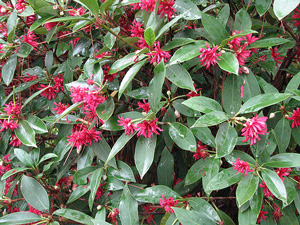Resource Library
Plant of the Week: Florida Anise
The University of Arkansas System Division of Agriculture does not promote, support or recommend plants featured in "Plant of the Week." Please consult your local Extension office for plants suitable for your region.
Plant of the Week
Florida Anise
Latin: Illicium floridanum

When we look at the contemporary Southern landscape, we see myriad plants being used, but the majority of these – with the exception of the large trees – are foreign-born. I’m not xenophobic and love foreign plants as much as our natives, yet I find it surprising so few of our natives have made the jump from wildling to mainstream landscape usage. Florida Anise (Illicium floridanum) is a flowering evergreen shrub that more Southern gardeners should know and use.
Florida anise is an evergreen shrub growing 10 to 12 feet tall and 6 to 8 feet wide. Traditionally, botanists have classified Illicium in its own monotypic family, but since 2009 it has been moved to the Schisandraceae (magnolia vine family). The new classification recognizes the early evolutionary history of the genus near the base of the ancient magnolia linage, which is thought to be the progenitor of broadleaf plants.
Two species of Illicium are found in the southeastern states, but most of the 40 described species are from Southeast Asia or Mexico. Florida anise ranges from the Florida panhandle to Louisiana, where it grows in ravines and wet areas near streams.
Florida anise leaves are 4 to 5 inches long, waxy to the touch, thick, leathery and highly aromatic when crushed. The petiole of the leaf is about a half-inch long and bright red. In the shade, the leaves are a deep, rich green, but if given too much sun, the foliage will yellow. The cherry red-to-burgundy flowers opening in mid- to late-spring are 2 inches across, with 20 to 30 strap-shaped petals borne on an inch-long peduncle. The flowers have a fragrance that one author likened to that of freshly caught fish.
The fruit is a whorled arrangement of elongated follicles (similar to those found in magnolia, except there the follicles are arranged in a cone), which flatten into a star-shaped structure, giving rise to another common name, star anise.
The star anise of the spice trade is derived from I. verum, an evergreen tree found in Vietnam and southern China. It contains anethole, an aromatic compound also found in anise seeds, which are produced from an herb in the carrot family. In addition to its use as a seasoning in traditional Asian and Indian cuisine, star anise also has medicinal properties. Oil extracts from the fruit produce shikimic acid, a precursor to the active ingredient of the anti-influenza Tamiflu drug we became acquainted with during the last bird flu epidemic scare.
Florida anise suffers from an image problem by gardeners outside of the Gulf Coast states because they fear it will be too tender to grow in their area. Surprisingly, it is reliably winter-hardy to -10 degrees Fahrenheit; in the winter freeze of 2011 I had a plant survive -22 degrees unscathed, but it was under a blanket of snow. This evergreen shrub is best-suited for shade, or at the most, morning sun. It makes an excellent evergreen plant for massing. It does best in a rich, organic soil that is uniformly moist. Once established, plants are said to have good drought resistance. Because the aromatic compounds in the foliage are poisonous, Florida anise is resistant to insect feeding and deer browse.
By: Gerald Klingaman, retired
Retired Extension Horticulturist - Ornamentals
Extension News - February 10, 2012
The University of Arkansas System Division of Agriculture does not maintain lists of retail outlets where these plants can be purchased. Please check your local nursery or other retail outlets to ask about the availability of these plants for your growing area.